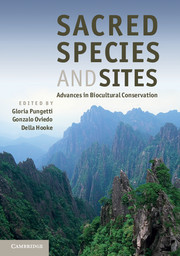Book contents
- Frontmatter
- Contents
- List of Contributors
- Foreword
- Preface
- Acknowledgements
- Introduction
- Part I Concepts and Knowledge
- Part II Sacred Landscapes
- Part III Sacred Sites and People
- Part IV Sacred Species
- Part V Sacred Animals
- Part VI Sacred Groves and Plants
- 21 The sacred tree in the belief and mythology of England
- 22 Sacred groves and biodiversity conservation: a case study from the Western Ghats, India
- 23 Cultural and conservation values of sacred forests in Ghana
- 24 Sacred species of Kenyan sacred sites
- Part VII Implementation and Conclusions
- Index
- Plate Section
- References
21 - The sacred tree in the belief and mythology of England
from Part VI - Sacred Groves and Plants
Published online by Cambridge University Press: 05 August 2012
- Frontmatter
- Contents
- List of Contributors
- Foreword
- Preface
- Acknowledgements
- Introduction
- Part I Concepts and Knowledge
- Part II Sacred Landscapes
- Part III Sacred Sites and People
- Part IV Sacred Species
- Part V Sacred Animals
- Part VI Sacred Groves and Plants
- 21 The sacred tree in the belief and mythology of England
- 22 Sacred groves and biodiversity conservation: a case study from the Western Ghats, India
- 23 Cultural and conservation values of sacred forests in Ghana
- 24 Sacred species of Kenyan sacred sites
- Part VII Implementation and Conclusions
- Index
- Plate Section
- References
Summary
Introduction
Many societies throughout the world have shared the concept of the sacred tree and there were many strong beliefs of this kind across pre-Christian north-western Europe. Living or symbolical trees have sometimes been identified at ritual centres and assembly sites, their presence open to various interpretations. This chapter examines how such belief was dealt with by early Christianity in England and how, despite replacement and suppression, belief in the power of trees often persisted in folk practices and folklore, refusing entirely to disappear. Today a new respect for trees and woodland recognises once again their value, not just as an economic resource, but in the preservation of the well-being of the earth.
Archaeological evidence and early literary evidence for sacred trees and tree symbolism
Although man has constructed temples and churches in which to practise religious rites from very early times, natural objects, too, such as trees, large stones or water features, have played a prominent role in spiritual concerns, whether as the abodes of spirits or gods or as means of accessing the spirit world. In this chapter the emphasis will be upon the role of trees as sacred objects. Our earliest evidence is necessarily archaeological and in Britain one finds living or symbolical trees forming a sacred function from at least the Bronze Age. In Norfolk at Holme next the Sea, a great upturned tree which had been set deliberately with its roots upwards some 4000 years ago was a great oak, uprooted in the spring of 2050 bc just as it was bursting into life; it was surrounded by a palisade of split poles, still carrying their bark on the outer side, which must have resembled, when standing, another great tree. This may have served as a mortuary table carrying the spirit of the dead down to a hidden realm, providing a union between this earth and a perceived underworld, or represent the life force of the tree itself being returned to the earth, the source of all life (Pryor, 2001, p. 276). There is a similarity here with The Tree of Eternity of the Hindu Veda texts: it has its roots in heaven above and its branches reach down to the earth ‘ancient Tree, whose roots grow upward, and whose branches grow downwards’ (Katha Upanishad, VI, 1965, p. 65).
- Type
- Chapter
- Information
- Sacred Species and SitesAdvances in Biocultural Conservation, pp. 307 - 321Publisher: Cambridge University PressPrint publication year: 2012
References
- 2
- Cited by



